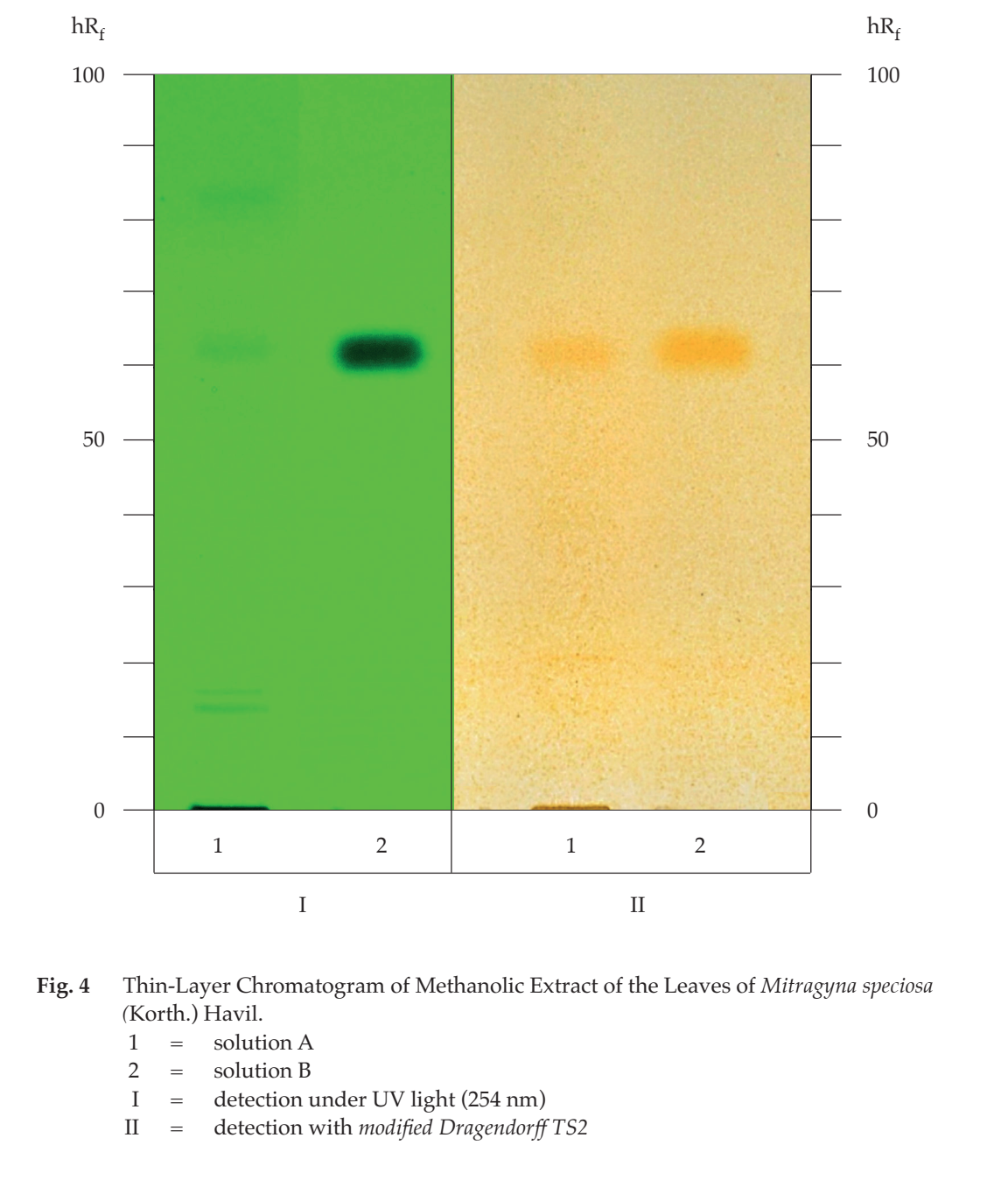ตำรามาตรฐานยาสมุนไพรไทย
Thai Herbal Pharmacopoeia
สำนักยาและวัตถุเสพติด กรมวิทยาศาสตร์การแพทย์ กระทรวงสาธารณสุข
Bureau of Drug and Narcotic, Department of Medical Sciences, Ministry of Public Health(Tinospora crispa (L.) Hook.f. & Thomson)
(Nelumbo nucifera Gaertn.)
(Centella asiatica (L.) Urb.)
(Centella Dry Extract)
(Centella Cream)
(Mesua ferrea L.)
(Piper sarmentosum Roxb.)
(Piper sarmentosum Roxb.)
(Pterocarpus santalinus L. f.)
(Santalum album L.)
(Senna tora (L.) Roxb.)
(Senna alata (L.) Roxb.)
(Senna Alata Tea)
(Piper retrofractum Vahl)
(Myristica fragrans Houtt)
(Andrographis paniculata (Burm. f.) Nees)
(Andrographis Capsules)
(Allium ascalonicum L.)
(Ocimum tenuiflorum L.)
(Curcuma longa L.)
(Turmeric Capsules)
(Turmeric Dry Extract)
(Turmeric Dry Extract Capsules)
(Arcangelisia flava (L.) Merr.)
(Curcuma sp.)
Harrisonia perforata (Blanco) Merr.
(Aristolochia pierrei Lecomte)
(Zingiber officinale Roscoe)
(Ginger Capsules)
(Ginger Tea)
(Cassia fistula L.)
(Nardostachys jatamansi (D. Don) DC.)
(Angelica sinensis (Oliv.) Diels)
Artemisia annua L.
(Ligusticum sinense Oliv. cv. Chuanxiong)
(Neopicrorhiza scrophulariiflora Pennell)
(Atractylodes lancea (Thunb.) DC.)
(Aucklandia lappa Decne)
(Terminalia chebula Retz.)
(Angelica dahurica (Hoffm.) Benth. & Hook. f. ex Franch. & Sav. var. dahurica)
(Kaempferia parviflora Wall. ex Baker)
(Hibiscus sabdariffa L.)
(Roselle Tea)
(Allium sativum L.)
(Zingiber zerumbet (L.) Sm.)
(Wurfbainia testacea (Ridl.) Škorničk.& A. D. Poulsen)
(Cannabis sativa L.)
(Myristica fragrans Houtt)
(Dracaena cochinchinensis (Lour.) S. C. Chen)
(Ficus racemosa L.)
(Hyptis suaveolens (L.) Poit.)
Clerodendrum indicum (L.) Kuntze
(Phyllanthus emblica L.)
(Citrus hystrix DC.)
(Citrus hystrix DC.)
(Areca catechu L.)
(Momordica charantia L.)
Moringa oleifera Lam.
(Aegle marmelos (L.) Corrêa)
(Solanum trilobatum L.)
(Morus alba L.)
Gynostemma pentaphyllum(Thunb.)
Makino
(Clinacanthus nutans (Burm. f.) Lindau)
(Cissus quadrangularis L.)
(Mimusops elengi L.)
(Zingiber montanum (J. König) Link. ex A. Dietr.)
(Piper betle L.)
(Capsicum annuum L.)
(Capsicum Oleoresin)
(Capsicum Gel)
(Piper nigrum L.)
(Piper nigrum L.)
(Eurycoma longifolia Jack)
(Thunbergia laurifolia Lindl.)
(Piper wallichii (Miq.) Hand.-Mazz.)
Senna garrettiana (Craib) H. S. Irwin & Barneby
(Terminalia bellirica (Gaertn.) Roxb.)
(Terminalia chebula Retz.)
(Caesalpinia bonduc (L.) H. Roxb.)
(Tarlmounia elliptica (DC.) H. Rob., S. C. Keeley, Skvaria & R. Chan)
(Hog Creeper Vine Dry Extract Capsiles)
(Hog Creeper Vine Dry Extract)
(Brachypterum scandens (Roxb.) Miq.)
(Lepidium sativum L.)
(Nigella sativa L.)
(Cuminum cyminum L.)
(Foeniculum vulgare Mill.)
(Plantago ovata Forssk.)
(Pimpinella anisum L.)
(Carum carvi L.)
(Anethum graveolens L.)
(Trachyspermum ammi (L.) Sprague)
Albizia procera (Roxb.) Benth.
(Acorus calamus L.)
(Tiliacora triandra (Colebr.) Diels)
Cyanthillium cinereum (L.) H. Rob.
(Orthosiphon aristatus (Blume) Miq.)
Murdannia loriformis (Hassk.) R. S. Rao & Kammathy
(Capparis micracantha DC.)
(Chrysopogon zizanioides (L.) Roberty)
(Cyperus rotundus L.)
(Cannabis sativa L.)
(Syzygium aromaticum (L.) Merr. & L. M. Perry)
(Boesenbergia rotunda (L.) Mansf.)
(Acanthus ebracteatus Vahl)
(Acanthus ilicifolius L.)
(Kaempferia galanga L.)
(Curcuma comosa Roxb.)
Betula alnoides Buch.-Ham. ex D. Don
Cannabis sativa L.
Carthamus tinctorius L
Mitragyna speciosa (Korth.) Havil
Mallotus repandus (Rottler) Müll. Arg
Azadirachta indica A. Juss. var. siamensis Valeton
Azadirachta indica A. Juss. var. siamensis Valeton
Punica granatum L.
Rhinacanthus nasutus (L.) Kurz
Baliospermum solanifolium (Burm.) Suresh
Curcuma aeruginosa Roxb
Boesenbergia kingii Mood & L. M. Prince
Senegalia rugata (Lam.) Britton & Rose
Acacia concinna (Willd.) DC.
Senegalia rugata (Lam.) Britton & Rose
Acacia concinna (Willd.) DC.
Senna alexandriana Mill. var. alexandriana
Cassia acutifolia Delile, Cassia angustifolia Vahl
Butea superba Roxb. ex Willd.
[Plaso superba (Roxb. ex Willd.) Kuntze, Rudolphia superba (Roxb. ex Willd.) Poir.
Pueraria candollei Graham
ex Benth. var. mirifica (Airy Shaw & Suvat.) Niyomdham
Streblus asper Lour.
Suregada multiflora (A. Juss.) Baill. (Gelonium
multiflorum A. Juss.
Kratom is the dried leaf of Mitragyna speciosa (Korth.) Havil. (Family Rubiaceae), Herbarium Specimen Number: DMSC 5333, Crude Drug Number: DMSc 1228.
Constituents Kratom contains indole alkaloids (e.g., corynantheidine, 7-hydroxymitragynine, mitragynine, paynantheine, speciociliatine, and speciogynine). It also contains flavonoids, triterpenoids, etc.
Description of the plant (Fig. 1) Briefly deciduous or evergreen tree, up to 33 m tall, sometimes buttressed; bark grey to greyish brown, smooth or scaly. Leaves simple, decussate, elliptic to ovate or obovate, 9 to 24 cm long, 3.5 to 12.5 cm wide, apex acuminate or acute, base mostly rounded to cordate, rarely cuneate or truncate, margin undulate, sometimes distally unevenly dentate with 1 to 5 teeth on each side, chartaceous to subcoriaceous, glabrous on both surfaces or glabrescent on veins below, midrib and secondary veins red, reddish green or pale green, raised below, secondary veins 10 to 17 pairs, pale hairy domatia in vein axils, tertiary veins scalariform; petiole red, reddish green or pale green, 2 to 4.5 cm long, glabrescent, shallowly grooved above; stipule interpetiolar, reddish green or green, elliptic, 3.5 to 6.5 cm long, 1 to 2.5 cm wide, keeled, glabrescent. Inflorescence terminal globose head, 3 to 4 cm in diameter, many-flowered, simple or compound dichasium-like; peduncle 0.3 to 1.3 cm long, glabrous; receptacle hairy; bract leaf-like, elliptic, 2.3 to 8(–15) cm long, 1 to 6.8 cm wide; interfloral bracteole spathulate, 5 to 6 mm long, 0.3 to 2 mm wide. Flower 5-merous; calyx pale green, tubular, 1 to 1.5 mm long, 2.5 to 3 mm in diameter, glabrous, lobe triangular, 0.3 to 0.7 mm long, 1 to 1.5 mm wide, apex acute, margin ciliate; corolla creamy white to pale yellow, becoming darker when aged, narrowly hypocrateriform, 5 to 6 mm long, 2 to 3 mm wide, lobe narrowly elliptic, 3 to 4.5 mm long, 1 to 2 mm wide, outside glabrous, inside densely long-hairy, stamens 5, protruding from corolla throat, filament 0.3 to 0.5 mm long, anther 1.7 to 2.2 mm long, protruding from corolla throat; ovary obovoid, 2 to 2.2 mm long, 1.5 to 2.2 mm, style slender, 0.9 to 1.3 cm long, glabrous, stigma mitriform, 2.2 to 3 mm long, 1 to 1.5 mm wide, style and stigma protruding from corolla throat. Fruiting head 1.5 to 2.7 cm in diameter; stalk 0.4 to 1.5 cm long, glabrous; fruit obovoid or turbinate, 0.5 to 1 cm long, 2 to 5 mm in diameter, green or dark green, becoming brown or blackish brown when dry, glabrous, with persistent calyx. Seeds numerous, narrowly elliptic, 3 to 4 mm long, 0.3 to 0.6 mm in diameter (including wings), brown, flattened, winged at both ends, sometimes lower wing bifid.
Description Odour, mild; taste, bitter and astringent.
Macroscopical (Fig. 1) Whole leaves and broken leaves. Whole leaves folded, mostly with petiole, petiole reddish, 1.6 to 3.5 cm long, lower leaf surface with reddish midrib and veins. Broken leaves, irregularly shaped and sized.
Microscopical (Figs. 2a, 2b, 2c, 2d, 2e) Transverse section of the leaf through the midrib shows upper epidermis, mesophyll, vascular tissue, and lower epidermis. Upper epidermis: a layer of rectangular cells, covered with cuticle layer; and unicellular trichomes, rarely 2- to 3-cellular trichomes. Mesophyll: layers of cylindrical palisade cells; some of which containing rosette aggregate crystals; spongy cells, irregularly shaped, loosely arranged, some of
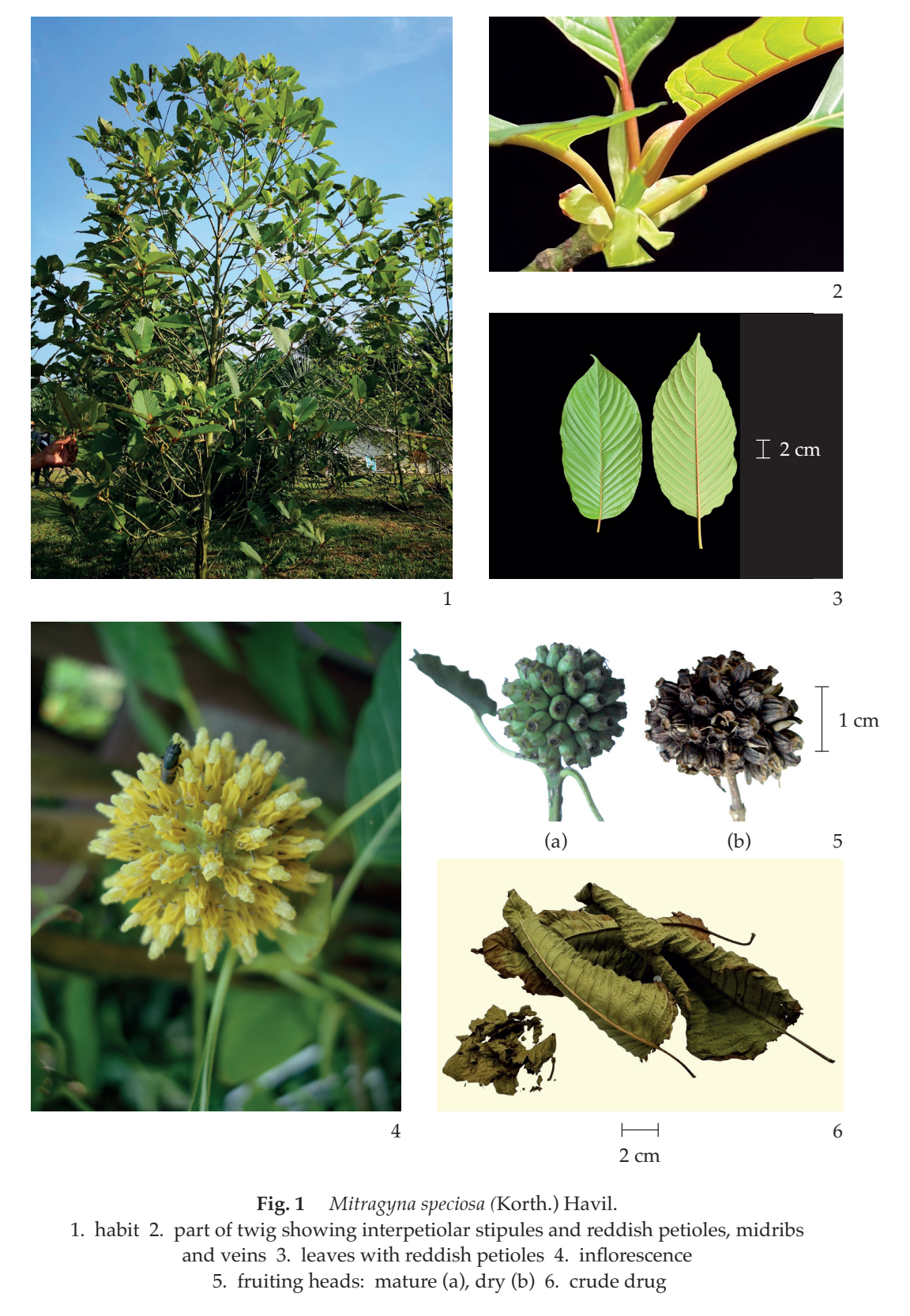

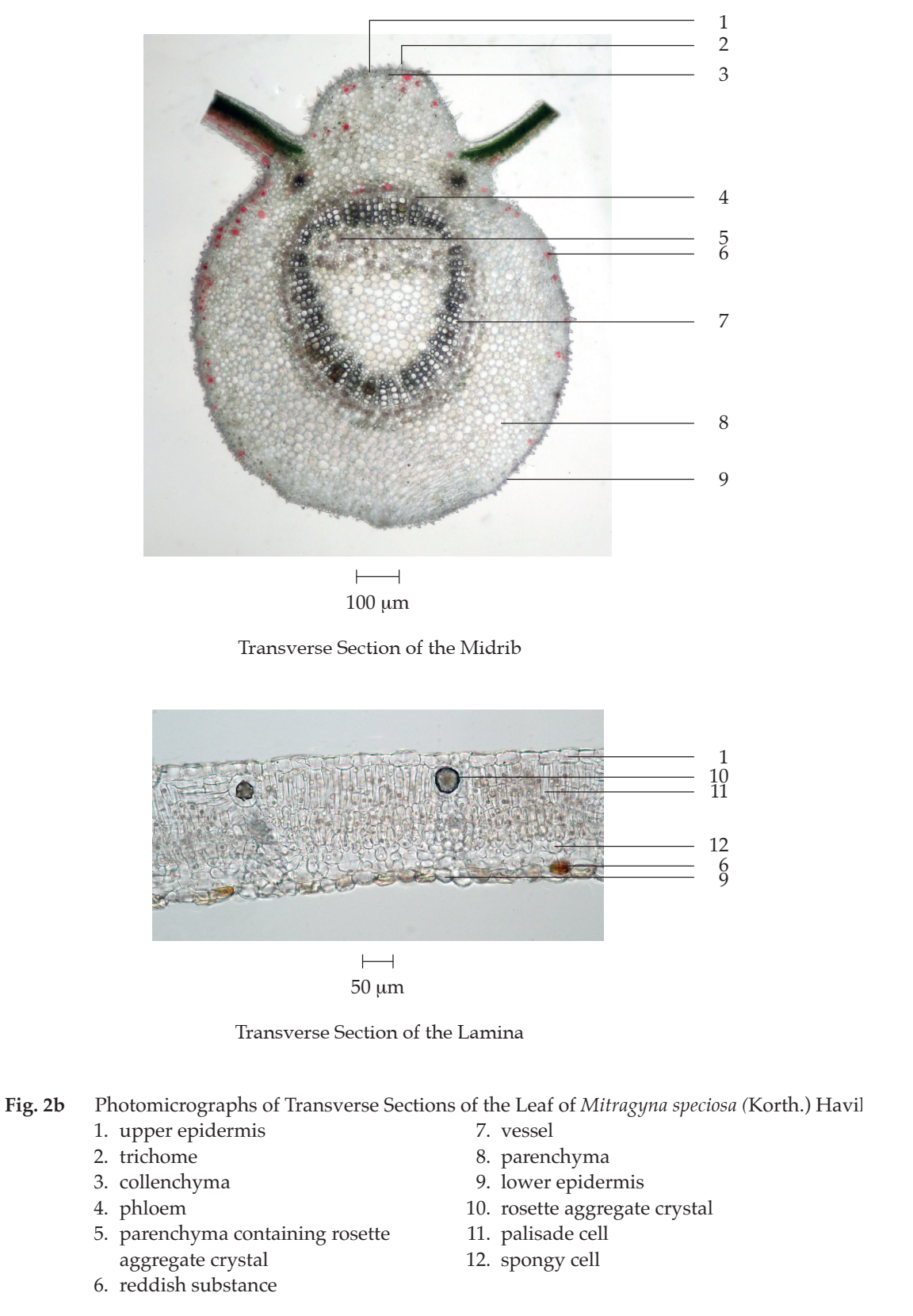
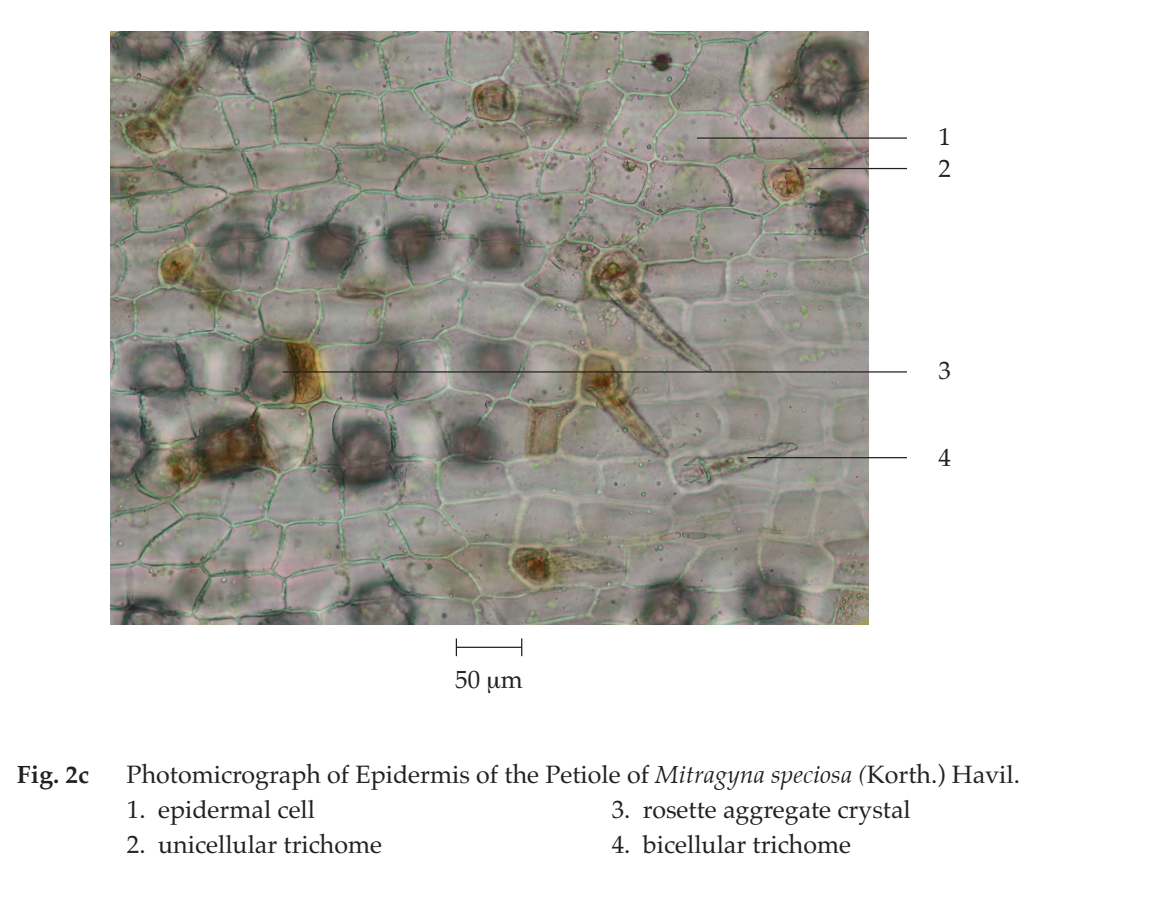
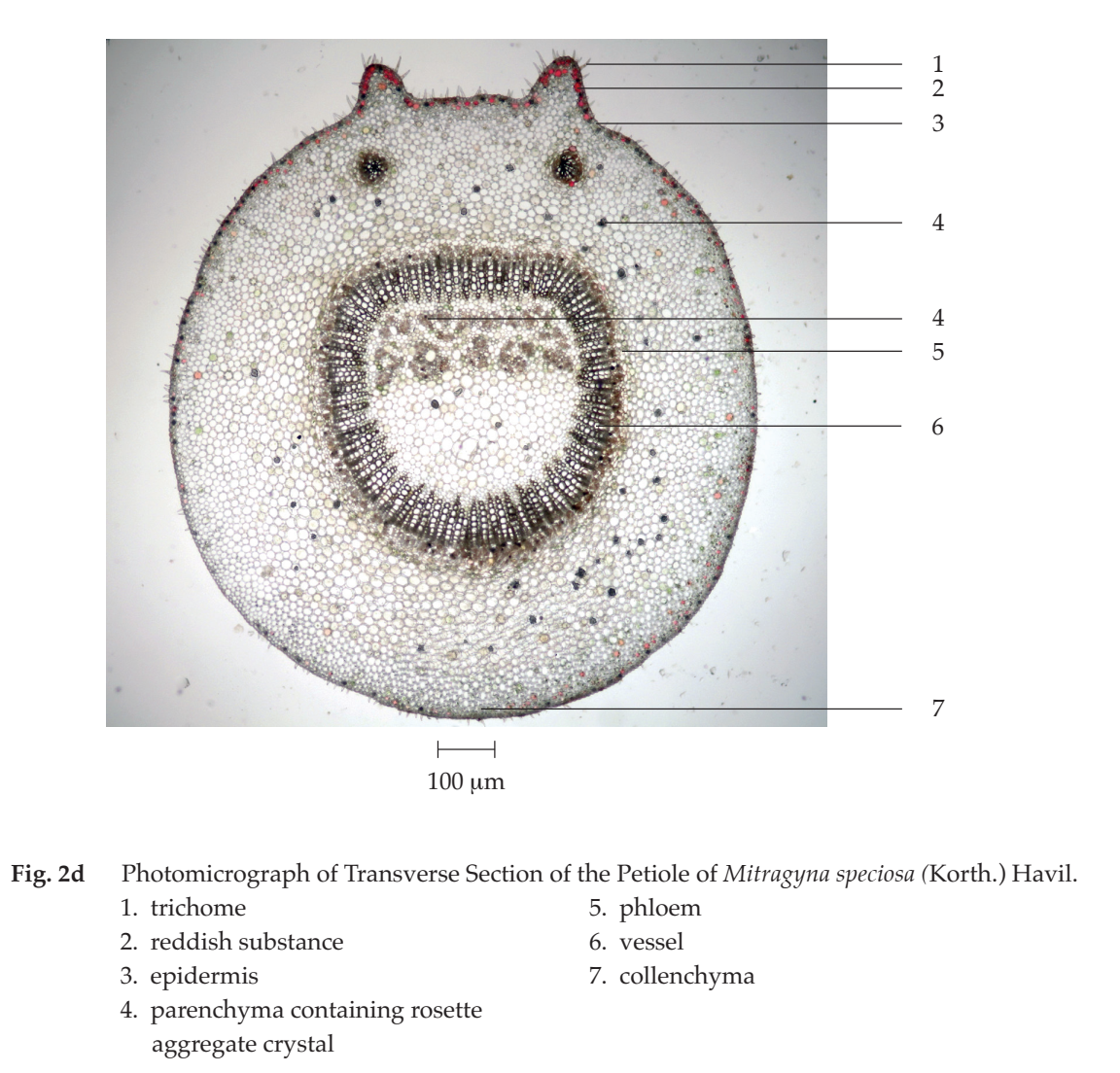

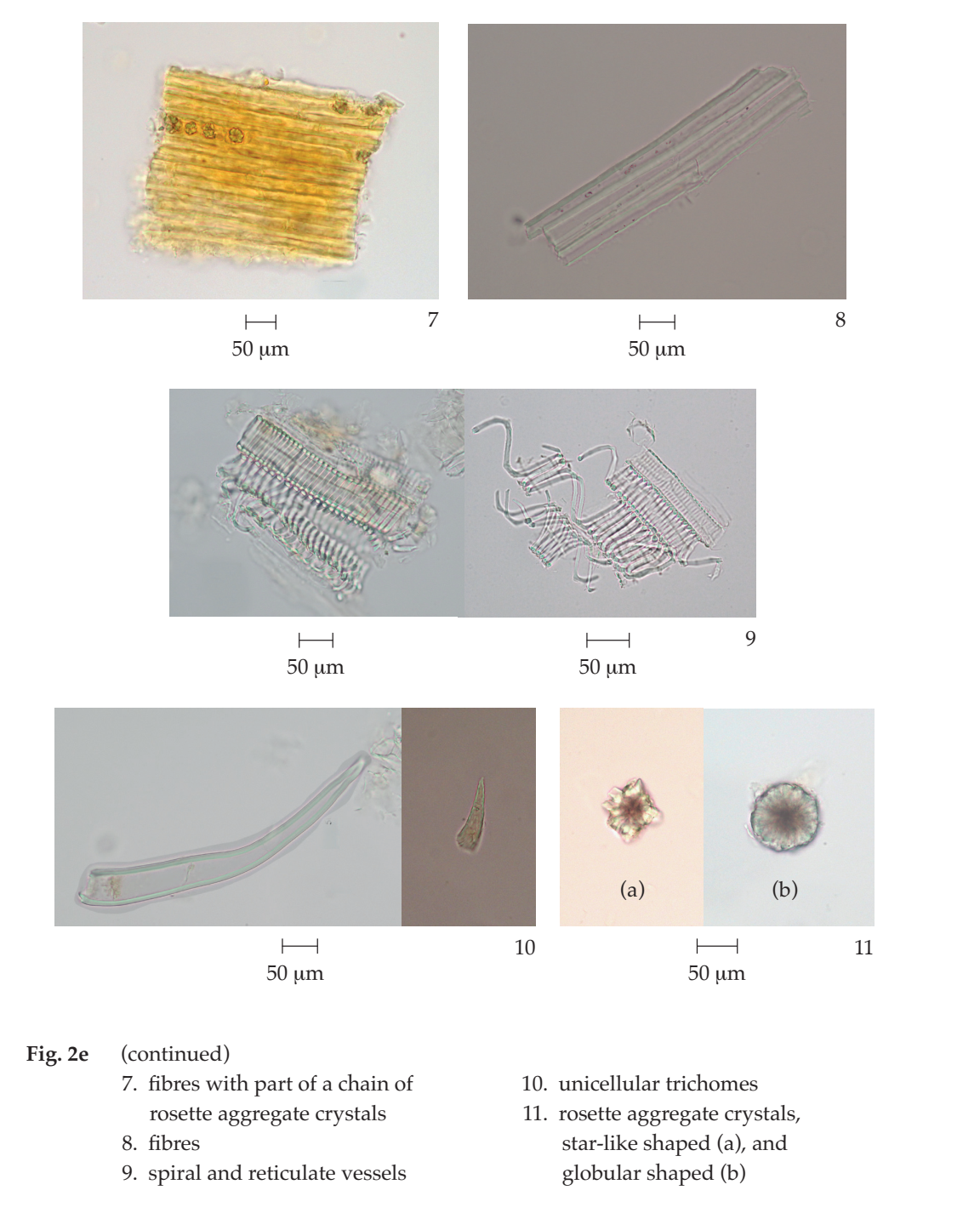
which containing reddish substance; angular collenchyma and parenchyma, some of which containing rosette aggregate crystals, or reddish substance in the upper and lower parts of the midrib. Vascular bundle: phloem and xylem. Lower epidermis: a layer of rectangular cells, covered with cuticle layer and unicellular trichomes, rarely 2- to 3-cellular trichomes.
In surface view, the lamina shows upper epidermis and lower epidermis. Upper epidermis: irregularly shaped. Lower epidermis: wavy, paracytic and anomocytic stomata; and unicellular trichomes, rarely 2- to 3-cellular trichomes.
Transverse section of the petiole illustrates epidermis, cortex, and vascular tissue. Epidermis: a layer of rectangular cells covered with cuticle layer; and unicellular trichomes, rarely 2- to 3-cellular trichomes. Cortex: angular collenchyma and thin-walled parenchyma, some containing rosette aggregate crystals or reddish substance. Vascular tissue: phloem and xylem.
In surface view, the petiole shows rectangular epidermal cells; unicellular trichomes, rarely 2- to 3-cellular trichomes; and rosette aggregate crystals arranged in long chains.
Kratom in powder possesses the diagnostic microscopical characters of the unground drug. Two different types of rosette aggregate crystals, star-like shaped and globular shaped, and reddish substance in parenchyma cells are characteristic.
Packaging and storage Kratom shall be kept in well-closed containers, protected from light, and stored in a dry place.
Additional information
1. It may be highly addictive in some individuals. It may cause hyperpigmentation of the cheeks, tremor, anorexia, weight loss, and psychosis in those with long-term addiction.
2. It has been used traditionally as a sedative opium substitute, an aid to opium-use cessation, and as a stimulant to combat fatigue, depending on amount taken and individuals.
3. There are 3 strains of Kratom cultivated in Thailand, i.e., Kan Daeng, Taengkwa, and Yak Yai. Since the “Kan Daeng” strain is more popularly used, it is therefore employed in establishing this monograph.
Identification
A. Reflux 1 g of the sample, in powder, with 25 mL of ethanol (80 per cent) for 10 minutes, allow to cool and filter (solution 1). To 1 mL of solution 1, add a few drops of iron(III) chloride TS: a dark green colour develops.
B. Evaporate 1 mL of solution 1 to dryness. Dissolve the residue in 0.5 mL of a 10 per cent v/v solution of sulfuric acid and add a few drops of modified Dragendorff TS2: an orange precipitate is produced.
C. The chromatogram of the Sample preparation shows several peaks, one of which corresponds to the mitragynine peak of the Standard preparations, as obtained in the Mitragynine content (Fig. 3).

Fig. 3 High-Performance Liquid Chromatogram of Kratom Showing Mitragynine (1)
D. Carry out the test as described in the “Thin-Layer Chromatography” (Appendix 3.1), using silica gel 60 F254 as the coating substance and a mixture of 50 volumes of n-hexane, 50 volumes of ethyl acetate, and 7.5 volumes of triethylamine as the mobile phase and allowing the solvent front to ascend 9 cm above the line of application. Apply separately to the plate as bands of 8 mm, 5 µL each solutions (A) and (B). Prepare solution (A) by sonicating 100 mg of the sample, in powder, with 10 mL of methanol for 30 minutes and filtering. For solution (B), dissolve 1 mg of mitragynine in 1 mL of methanol. After removal of the plate, allow it to dry in air and examine the plate under ultraviolet light (254 nm), marking the quenching bands. The chromatogram obtained from solution (A) shows a quenching band (hRf value 61 to 63), corresponding to the mitragynine band obtained from solution (B). Spray the plate with modified Dragendorff TS2; the band due to mitragynine is yellowish orange. Another yellowish orange band is also observed (Fig. 4).
Loss on drying Not more than 7.0 per cent w/w after drying at 105° to constant weight (Appendix 4.15).
Foreign matter Not more than 2.0 per cent w/w (Appendix 7.2).
Total ash Not more than 6.0 per cent w/w (Appendix 7.7).
Ethanol (80 per cent)-soluble extractive Not less than 25.0 per cent w/w (Appendix 7.12).
Water-soluble extractive Not less than 19.0 per cent w/w (Appendix 7.12).
Mitragynine content Not less than 1.0 per cent w/w of mitragynine (C23H30N2O4), calculated on the dried basis. Carry out the determination as described in the “Liquid Chromatography” (Appendix 3.5).
Diluent Prepare a mixture of 8 volumes of methanol and 2 volumes of a 0.1 per cent v/v solution of glacial acetic acid.
Buffer solution Dissolve 1.54 g of ammonium acetate in 500 mL of water, adjust with glacial acetic acid to pH 6.0, and dilute to 1000.0 mL. Filter through a membrane having a 0.45-µm porosity.
Mobile phase Prepare a mixture of 65 volumes of acetonitrile and 35 volumes of Buffer solution. Filter through a membrane having a 0.45-µm porosity.
Standard preparations Dissolve a suitable quantity of Mitragynine RS in sufficient Diluent to obtain a stock solution having a known concentration of about 1 mg of mitragynine per mL. Dilute the solution quantitatively and stepwise with the same solvent to obtain five solutions having known concentrations of 10, 20, 40, 60, and 100 μg of mitragynine per mL. Filter through a membrane having a 0.45-µm porosity.
Sample preparation Transfer about 50 mg of Kratom, in fine powder and accurately weighed, to a 10-mL volumetric flask and add 7 mL of Diluent. Sonicate for 30 minutes, allow to cool to room temperature, and adjust to volume with the same solvent. Centrifuge the resulting solution at 3000 × g for 5 minutes. Transfer 5.0 mL of the supernatant to a 10-mL volumetric flask, dilute with Dilent to volume, and filter through a membrane having a 0.45-µm porosity.
Chromatographic procedure The chromatographic procedure may be carried out using (a) a stainless steel column (25 cm × 4.6 mm) packed with octadecylsilane chemically bonded to porous silica or ceramic microparticles (5 µm), (b) Mobile phase at a flow rate of 1.0 mL per minute, and (c) an ultraviolet photometer set at 225 nm.
To determine the suitability of the chromatographic system, chromatograph Standard preparation having a known concentration of 40 μg per mL, and record the peak response as directed under Procedure and Calculation: the relative standard deviation for replicate injections is not more than 2.0 per cent. The symmetry factor for mitragynine peak is not more than 1.5.
Procedure and Calculation Separately inject about 20 μL of Standard preparations into the chromatograph, record the chromatograms, and measure the responses for the mitragynine peaks. Plot the readings and draw the standard curve of best fit: the curve shows the correlation coefficient of not less than 0.999. Inject about 10 µL of Sample preparation into the chromatograph, record the chromatogram and measure the response for mitragynine peak. By reference to the standard curve, calculate the content of mitragynine (C23H30N2O4) in the portion of the Kratom taken.
